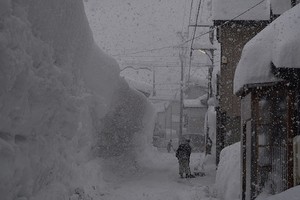By RYUJIRO KOMATSU/ Staff Writer
January 13, 2023 at 17:49 JST
Some front-line doctors say the COVID-19 situation is now at the worst level for health services since the pandemic began.
The number of infected patients has been surging again since the year-end and New Year holiday period, the first in three years that was free from virus-related restrictions.
A single-day record of 520 COVID-19-related deaths were reported across Japan on Jan. 11, according to Asahi Shimbun calculations, while hospital beds continue to fill up with seriously ill infected patients.
Some medical facilities are so strained that they cannot accept emergency patients.
Yet the current eighth wave of infections in Japan could get worse because the public has been letting its guard down, said Kazuma Tashiro, director of Hinata Zaitaku Clinic Sanno in Tokyo’s Shinagawa Ward.
“The infections are becoming more common at a level never seen before, but society is significantly less worried about it now,” he said.
Tashiro, who frequently makes home visits, treated a COVID-19 patient in his 40s just after noon on Jan. 11. The 33-year-old doctor had to rush to the patient’s home after being informed that his condition had deteriorated.
He quickly administered an intravenous drip to the patient who was in bed with shallow breathing.
Many of Tashiro’s COVID-19 patients have underlying health conditions or are elderly. More than 100 of them have died in the pandemic.
How quickly they can receive treatment often determines whether they can survive.
Before the eighth wave started, most of the COVID-19 patients Tashiro saw were referred to him by a local public health center.
However, since the eighth wave began, he said he can never relax because his regular patients with underlying health conditions, such as cancer, have also caught the novel coronavirus.
According to the health ministry, the number of COVID-19 patients in Japan in the week up to Jan. 10 was 934 per 100,000 people, 1.28 times the figure for the previous week.
According to the Cabinet Secretariat, more than 50 percent of hospital beds set aside for COVID-19 patients were occupied in 35 prefectures as of Jan. 12.
In Tokyo, 55 percent of such beds were filled, while the ratio reached 85 percent in Kanagawa Prefecture, 81 percent in Shiga Prefecture, and 79 percent in Fukuoka Prefecture.
Health workers are also struggling to rush patients to hospitals.
According to the Fire and Disaster Management Agency, in the week until Jan. 1, there were 7,158 cases in which officials had difficulty finding hospitals that would accept COVID-19 patients.
Tashiro said that when he recently called the medical emergency 119 number, he had to wait 40 minutes before he could speak to an operator.
Exacerbating the situation is Japan’s first influenza epidemic in three years.
The government confirmed the influenza epidemic at the end of last year after the weekly number of influenza patients reported by designated medical institutions surpassed one per institution.
Recently, the figure has been more than two influenza patients per medical institution.
Tashiro now carries test kits that simultaneously detect COVID-19 and seasonal influenza when he visits patients at their homes.
Around 42,000 hospitals or clinics across Japan now treat COVID-19 patients, nearly 1.75 times the 24,000 reported in November 2020.
But the latest figure represents only about 60 percent of medical institutions with internal medicine departments.
“Unless there is an arrangement in which COVID-19 patients can be treated at their usual hospitals or clinics, just like influenza patients can, the same situation will be repeated forever,” Tashiro stressed.




















A peek through the music industry’s curtain at the producers who harnessed social media to help their idols go global.
A series based on diplomatic documents declassified by Japan’s Foreign Ministry
Here is a collection of first-hand accounts by “hibakusha” atomic bomb survivors.
Cooking experts, chefs and others involved in the field of food introduce their special recipes intertwined with their paths in life.
A series about Japanese-Americans and their memories of World War II